Featured Topics
Featured series.
A series of random questions answered by Harvard experts.

Explore the Gazette
Read the latest.

Courtney B. Vance, Angela Bassett honored as Artists of the Year

Is Beyoncé’s new album country?
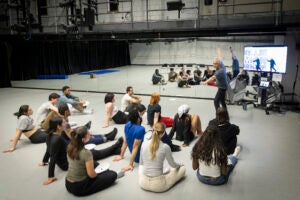
Storytelling through body language
Armchair travels with a purpose.
Students wearing 3D glasses take a virtual tour of ancient Egypt in Peter Der Manuelian’s “Pyramid Schemes” class.
Photos by Stephanie Mitchell/Harvard Staff Photographer
Alvin Powell
Harvard Staff Writer
Digital Giza Project lets scholars virtually visit sites in Egypt and beyond, and even print them in 3D
Four thousand years ago, a member of Egypt’s elite was buried on the Giza Plateau in an elaborate stone tomb, complete with several rooms and underground chambers.
Then, in 1912, a team from Harvard University and the Museum of Fine Arts (MFA) in Boston excavated the tomb, of a type called a mastaba , and brought back with them a limestone wall from its chapel.
The wall, housed at the MFA, is inscribed with images of the deceased, an official named Akh-meret-nesut, and his family in various poses — sitting, leaning on a staff, throwing a lasso.
Today, more than a century later, Harvard doctoral student Inês Torres wants to know as much as she can about Akh-meret-nesut: who he was, what he did, and why he was buried on the Giza Plateau in the shadow of the pyramids long after pharaohs’ burials there had ceased.
But Torres faces a problem familiar to many scholars studying ancient Egypt: getting access to what she’s studying. With part of the tomb in Boston and part in Egypt, she’d have to time travel to see it intact. Other scholars may face different hurdles, but the problem is the same: Documents and images are held in faraway archives, artifacts and other relics of ancient Egypt have been dispersed, stolen, or destroyed, and tombs and monuments have been dismantled, weather-worn, or locked away behind passages filled in when an excavation closes.
Hurdles can also be economic: The object of study may be intact, but the plane fare and expenses of living for weeks in the field or lodged in the cities — Cairo, London, Berlin, Paris, Boston — that are home to museums with large Egyptian collections hard to come by.
It was with scholars like these in mind that Digital Giza Project was born.
The project was created in 2000 by Peter Der Manuelian , who at the time was on the curatorial staff at the MFA. A scholar of ancient Egypt, Manuelian said his initial vision was to create a digital record of the work of Harvard’s legendary Egyptology Professor and MFA curator George Reisner and the Harvard-MFA Expedition he led. The expedition was one of the major academic archaeological efforts at Giza and other sites in Egypt during the early 1900s.
Reisner, who led the expedition for more than 40 years, dug at 23 sites, and Manuelian soon realized that just digitizing material relating to the vast finds on the Giza Plateau — which includes not only the pyramids and the Sphinx, but also associated temples, nearby cemeteries, and even a workers’ village — would be a career-long challenge. In 2010, he moved to Harvard to become the Philip J. King Professor of Egyptology and director of the Harvard Semitic Museum , and he brought the Giza Project with him.
The project staff’s ambition has since expanded to include not just Reisner’s work at Giza, but that of other archaeologists at the site as well, making it a comprehensive resource for Giza archaeology. It contains some 77,000 images, 21,000 of them Harvard University-MFA Expedition glass-plate negatives, and 10,000 of Manuelian’s own images. It has published manuscripts as well as unpublished expedition records, dig diaries, object record books, and sketches and drawings made by the archaeologists doing the digging. In January, during Harvard’s winter recess, Manuelian visited Egypt and collected another 5,000 digital images — including panoramic photos — of Giza and related objects in the Egyptian Museum in Cairo.
A key feature of the Giza Project is the fact that the material it holds is cross-referenced online, allowing a researcher to seamlessly move from a 3D image of an object to scholarly articles about it to diary pages by the archaeologist who discovered it.
“For people who focus on this particular period, this is the main resource for them to go to,” Manuelian said. “It’s thrown the doors wide open to this material that was previously only in the publications that Reisner lived long enough to finish.”
As the work has advanced, so has technology. Manuelian’s vision has expanded to include 3D re-creations of statues and artifacts that allow researchers to view them online, rotate them, and zoom in on specific features. Looking to the future, he said, 3D models’ source codes could be made available, which would allow distant scholars with access to 3D printers to create their own physical models.
“All of this allows us to ask new questions and to put the data together in ways not possible before and to make intelligent links,” Manuelian said. “If someone gets a grant and decides to go to the MFA and look through their records, good luck. There’s just so much, it’s overwhelming. If you go to Giza today, a tomb may have been reburied or vandalized, or is in not as good shape as it was in 1916. Objects might have gone to the basement of the Cairo museum, never to be seen again.
“With our attempt to put this all together digitally, with diaries and maps and plans and things, it allows you, first of all, convenient access to the data and then you can start to notice patterns.”
The Giza Projects’ 3D modeling extends beyond artifacts to locations. Manuelian’s team has already created video-game-like 3D versions of the entire Giza Plateau, with the Khafre pyramid, the Sphinx, and several temples and tombs posted so far and more to come. Those models can be accessed from the Digital Giza website and toured using controls on a laptop or desktop computer. Other re-creations, using high-resolution photographs of tombs’ interiors, let visitors walk through virtual burial chambers using stereo headsets. Visitors can move around inside the tombs and even walk up to a wall to examine a particular relief or other detail. About 20 tombs have been modeled in detail so far, with hundreds more to go.
“My hope is eventually to fly drones over the site, documenting everything from the air,” Manuelian said. “And complementing that with walks up and down the ‘streets’ [between rows of tombs] creating 360-degree panoramic visualizations, all linked to the more-traditional archaeological data that we have already assembled.”
For someone like Torres, studying a tomb that has one room in Boston and the rest in Egypt, a virtual model is the only way to see the intact structure, so she’s planning on creating one as part of her doctoral work.
“This tomb is divided between two countries,” she said. “3D modeling is the only way we can put it back together again.”
The overarching goal, Manuelian said, is to make scholarship in Egyptology more accessible than ever. And, while digital images may not fully replace the real thing, he said, foundational study can be conducted using the wide array of material presented by the project, allowing scholars to conserve scarce resources for when they’re essential.
The project’s 3D re-creations and data visualizations, together with the capabilities of the Harvard Visualization Center, also allow the Giza Project to give students a unique educational experience. Last fall, Manuelian gathered his students in a tomb in cyber space, using the center’s virtual reality headsets, and linked the class to students in Zhejiang University in China. Students’ avatars gathered at the virtual site — in this case, the Sphinx — with the technology, allowing Manuelian to act as a cyber tour guide.
“The project is all of these diverse approaches,” Manuelian said. “It’s a traditional database and website. It’s the intelligent linking of this photo to that tomb to this diary page. It’s the 3D modeling as we try to build more and more of the necropolis all the time. And it’s ultimately intended to enable the kind of remote teaching — what I call educational telepresence — where we can all be at Giza virtually and visiting the site and having a lecture inside a decorated tomb chapel no matter where you live.”
Torres said there is an irony to studying Giza: It is one of the world’s most famous archaeological sites, but in many ways it is still unknown. While the pyramids and Sphinx are world-famous, and have been for centuries, in their shadow new tombs are still being uncovered, while known tombs, workers’ houses, and other sites are yet to be fully explored and studied.
“Giza is such a well-known site, but in some sense, it’s understudied,” Torres said. “Because the pyramids are so amazing, the things all around them fade.”
With so much work to be done, the access to digitized documents and materials might inspire scholars curious about ancient Egypt but without access to the sites themselves or a major Egyptological library to take up the job.
“I think that’s the way to go forward, to make sure everyone has access,” Torres said. “Possibly there are geniuses who don’t have a great library and could do something wonderful with the information.”
Another graduate student, Hilo Sugita, plans to study the sarcophagi found at Giza. Using the Giza Project’s data, she can examine photographs of inscriptions, find their original locations within tombs, and even create 3D models.
More like this
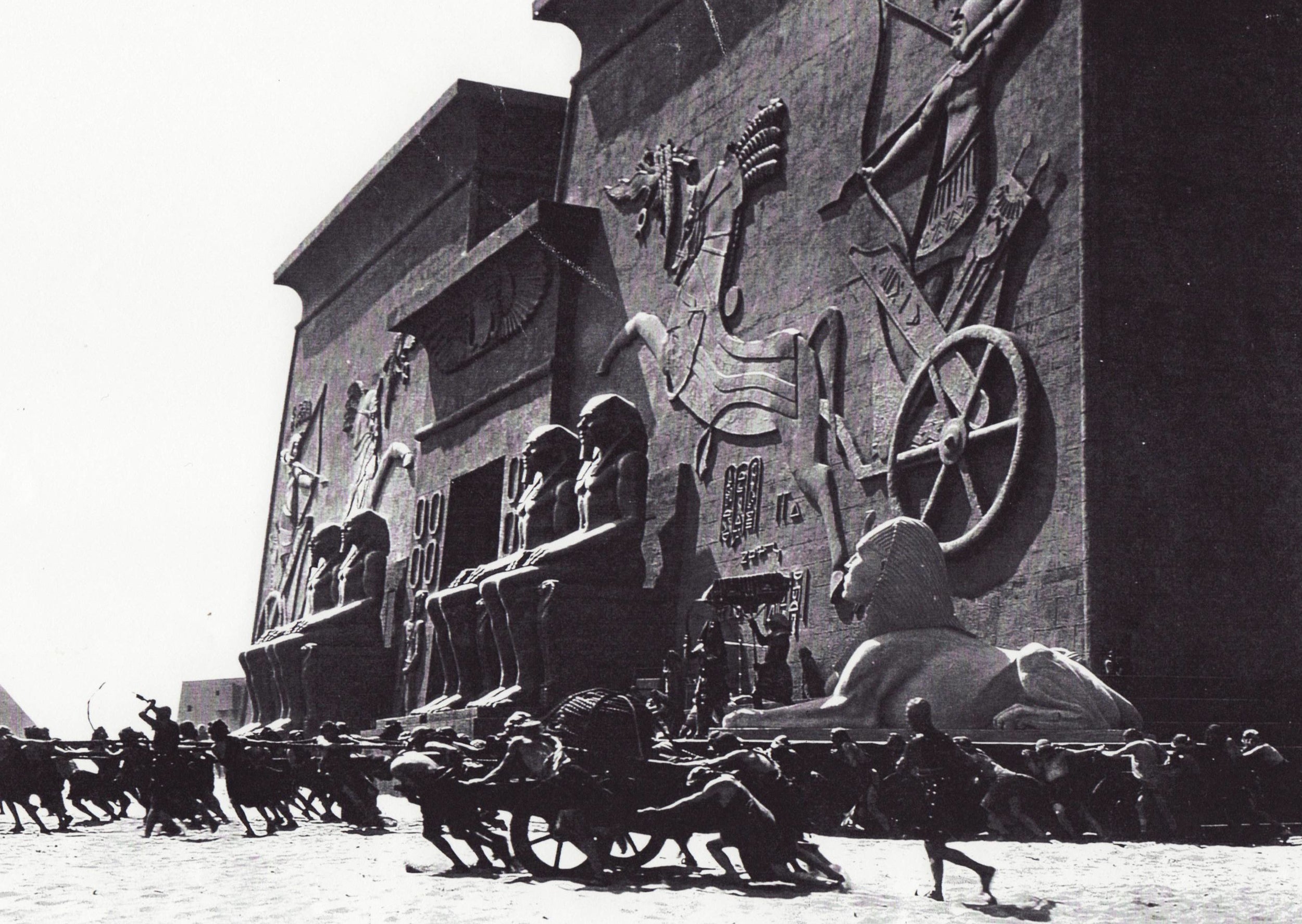
The search for a California sphinx
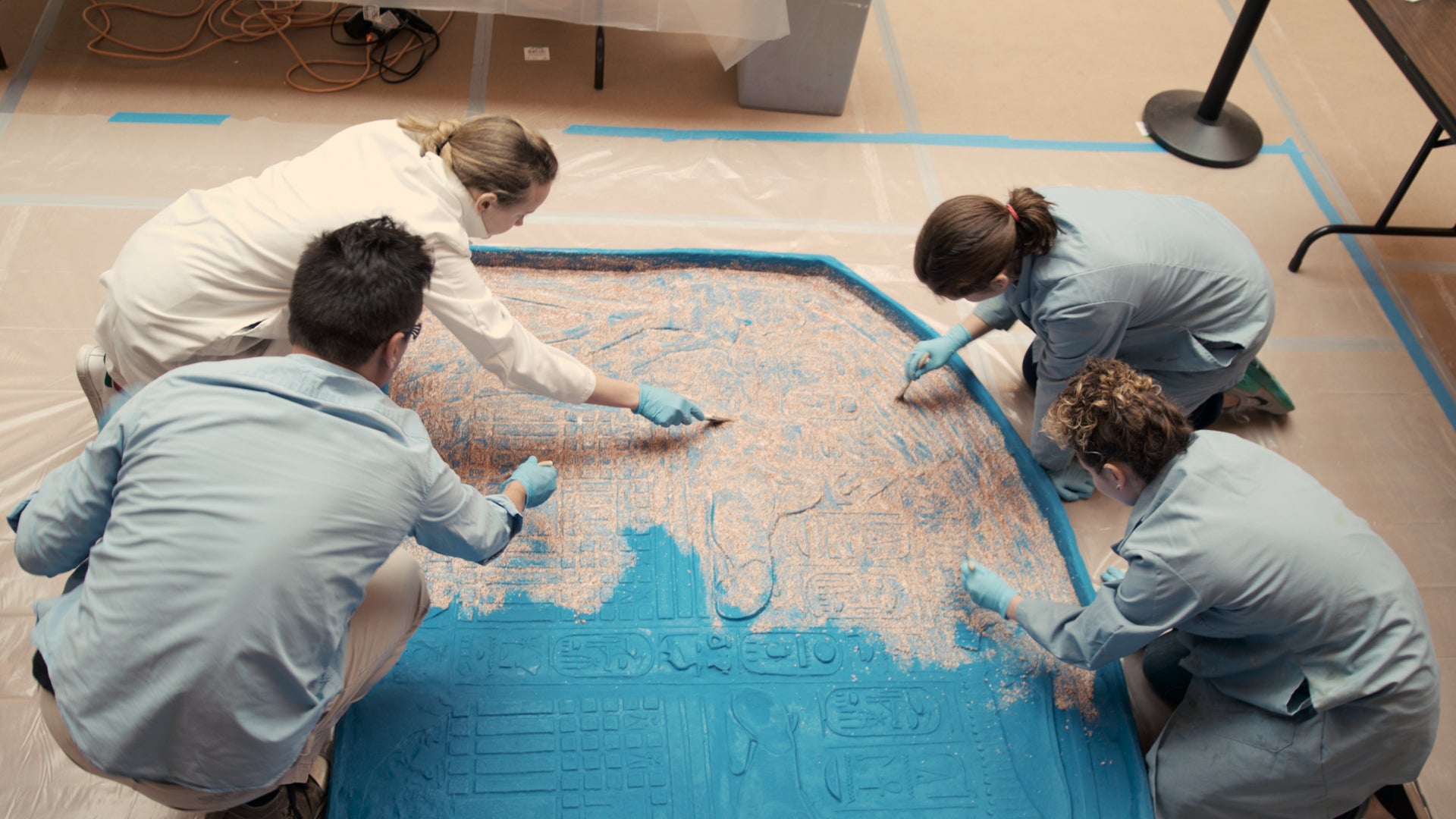
A cast fit for an Egyptian king
“We have photographs, journals, glass negatives, letters, artifacts, publications,” Sugita said. “I think the Digital Giza Project is amazing because we’re trying to collect all the data about Giza everywhere and make it available on the website. You don’t have to go to the MFA, you don’t have to travel to Berlin.”
Technology’s advance is not without challenges, however. The digitization of archaeology, Manuelian said, is something like “the Wild West,” with competing file formats and uncertainty about how the growing data troves will be translated into next-generation software.
In addition, standards for what goes into a 3D re-creation are loose. Should a digital model reflect the state of a tomb as it was found, for example, or is it OK to color in reliefs on the walls to match paint residue found there? How far should digital re-creations go in filling in missing details, some of which are backed by scholarship, but others of which are more speculative, driven by knowledge of common practice rather than evidence at that specific site?
Early in the spring term, Manuelian gave students in his Gen Ed “Pyramid Schemes” class, which provides an overview of ancient Egypt, a glimpse of Giza using Giza Project models. The students visited the Harvard Visualization Center’s home on the second floor of the Geological Museum building, which is equipped with a curved floor-to-ceiling screen occupying one full wall and a suite of 3D and virtual reality tools.
He gave them a tour of both the technology — which can depict sites in detail — and the archaeology, showing them three-dimensional re-creations viewed with 3D glasses and letting them walk through a tomb via a virtual-reality headset.
Manuelian also encouraged students to not only soak up the experience, but to think about the challenges inherent in such an approach, where it might further education and scholarship, and what its shortcomings might be. And, with so much work still to do, he also made a pitch.
“This is a project that is waiting for people like you,” he said.
Share this article
You might like.
Cultural Rhythms’ weeklong celebration highlights student performers, food, and fashion

Release ignites hot talk about genre’s less-discussed Black roots, what constitutes authenticity
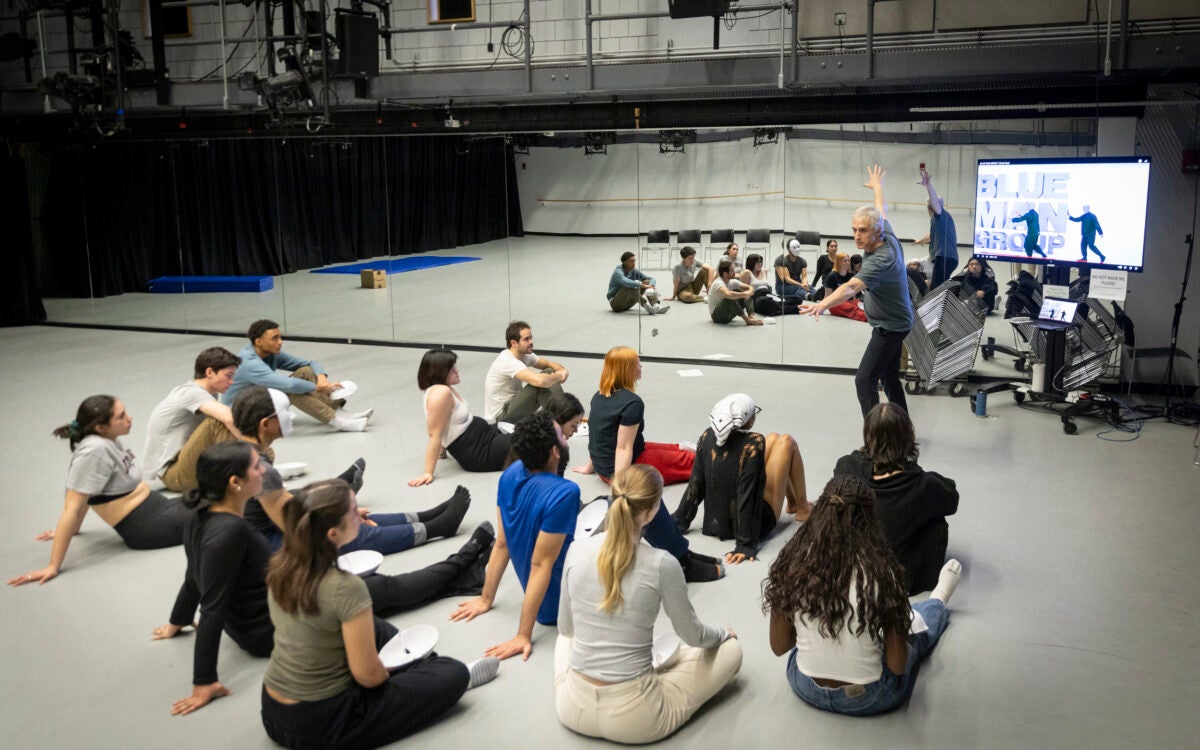
Veteran of Blue Man Group teaches students art of building a character without saying a word
College accepts 1,937 to Class of 2028
Students represent 94 countries, all 50 states
Forget ‘doomers.’ Warming can be stopped, top climate scientist says
Michael Mann points to prehistoric catastrophes, modern environmental victories
Pushing back on DEI ‘orthodoxy’
Panelists support diversity efforts but worry that current model is too narrow, denying institutions the benefit of other voices, ideas
Pyramids of Giza: Ancient Egyptian Art and Archaeology
Learn about ancient egypt’s most famous archaeological site.
Join Harvard Professor Peter Der Manuelian in exploring the archaeology, history, art, and hieroglyphs surrounding the famous Egyptian Pyramids at Giza.

What You'll Learn
Where is Giza? How were the Pyramids built? How did the cemeteries and hundreds of decorated tombs around them develop? What was Giza’s contribution to this first great age of ancient Egyptian civilization, the Old Kingdom?
The Giza Plateau and its cemeteries — including the majestic Pyramids and the Great Sphinx — are stirring examples of ancient Egyptian architecture and culture. They provide windows into ancient Egyptian society, but also contain mysteries waiting to be solved. The Egyptian Pyramids at Giza provide an opportunity to explore the history of archaeology and to learn about some of the modern methods shaping the discipline today.
This introductory course will explore the art, archaeology, and history surrounding the Giza Pyramids. We will learn about Egyptian pharaohs and high officials of the Pyramid Age, follow in the footsteps of the great 20th-century expeditions, and discover how cutting-edge digital tools like 3D-modeling are reshaping the discipline of Egyptology.
Join us on this online journey to ancient Egypt’s most famous archaeological site as we uncover the history and significance of Giza, and use new digital techniques to unravel the mysteries of its ancient tombs and temples.
The course will be delivered via edX and connect learners around the world. By the end of the course, participants will understand:
- The history and significance of the Giza Pyramids and surrounding cemeteries
- Who explored the Pyramids and how they documented their discoveries
- The cultural and religious significance of the Giza Pyramids, tombs, and temples
- The role of hieroglyphic inscriptions in the tombs at Giza
- An appreciation for Egyptian art of the Old Kingdom, or Pyramid Age
- How digital technologies allow us to visualize ancient monuments in new ways
- What the future holds for our understanding and experience of Giza
Your Instructor
Peter Der Manuelian received his Ph.D. in Egyptology from the University of Chicago in 1990. In 2009, he was appointed the “Philip J. King Professor of Egyptology” at Harvard University (Department of Near Eastern Languages and Civilizations, and Department of Anthropology). This is the first Egyptology chair at Harvard since the time of George Reisner (1867-1942), more than 75 years ago. He is director of the Harvard Semitic Museum, and also directs the Giza Project at Harvard, and the MA Program in Museum Studies at the Harvard Extension School. He joined the curatorial staff at the Museum of Fine Arts, Boston, in 1987, and was Giza Archives Project Director there from 2000–2011, in addition to teaching at Tufts University for ten years. His primary research interests include ancient Egyptian history, archaeology, digital epigraphy and visualization, the development of mortuary architecture, and the (icono)graphic nature of Egyptian language and culture in general.
Ways to take this course
When you enroll in this course, you will have the option of pursuing a Verified Certificate or Auditing the Course.
A Verified Certificate costs $219 and provides unlimited access to full course materials, activities, tests, and forums. At the end of the course, learners who earn a passing grade can receive a certificate.
Alternatively, learners can Audit the course for free and have access to select course material, activities, tests, and forums. Please note that this track does not offer a certificate for learners who earn a passing grade.
Related Courses
Masterpieces of world literature.
Join Harvard faculty, David Damrosch and Martin Puchner, in this online course to embark on a global journey to explore the past, present, and future of world literature.
Leaders of Learning
Explore and understand your own theories of learning and leadership. Gain the tools to imagine and build the future of learning.
Religious Literacy: Traditions and Scriptures
Led by Harvard faculty, this course will help you learn to better understand the complex ways that religions function in historic and contemporary contexts.
Advertisement
Harvard, MFA Unveil Virtual 3D Tour Of Ancient Egyptian Pyramids
Copy the code below to embed the wbur audio player on your site.
<iframe width="100%" height="124" scrolling="no" frameborder="no" src="https://player.wbur.org/news/2012/05/07/virtual-tour-egypt"></iframe>
- Lynn Jolicoeur
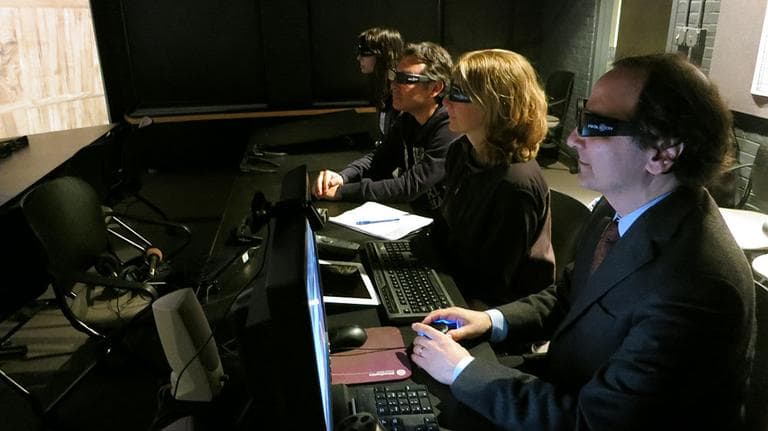
3D has become all the rage in movies and computer games, but the technology isn't just for entertainment. Researchers at Harvard University and the Museum of Fine Arts are turning it into a learning tool, too. Beginning Tuesday, they're offering you a free 3D virtual tour of the ancient pyramids of Egypt.
"I don't play video games," Peter Der Manuelian said with a laugh. "This is as close as I'll ever come, but it's great fun."
Manuelian is one of the brains behind this project, called Giza 3D. He's been fascinated by ancient Egypt ever since fourth-grade history, and he eventually turned that childhood fascination into a profession: he's Harvard's full-time Egyptologist. In a classroom with a curved floor-to-ceiling screen, he gave me some fancy battery-operated 3-D glasses.
"So put the glasses on, and then push the button," he instructed, "and if the image gets a little darker, you'll know that things are working."
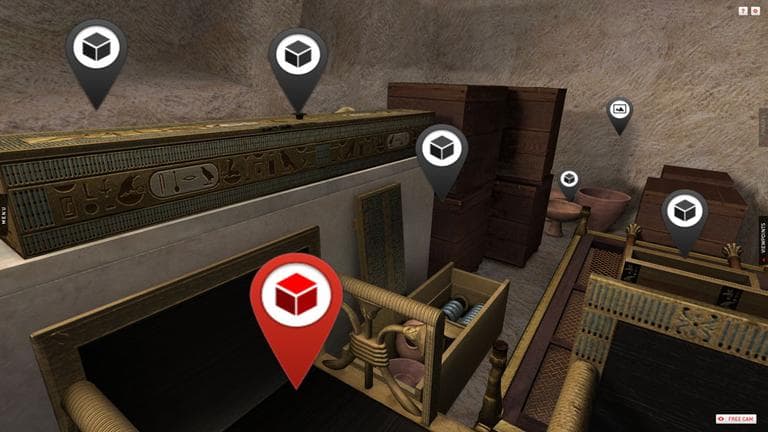
And with that, I get a taste of what anyone with an Internet connection and 3D TV will soon be able to experience.
"So what we're seeing, then, is the Great Pyramid and its temples and long causeway, and the sun is going down to the west," Manuelian said.
It's an animated computer rendering of the Giza Plateau, home to the famous pyramids near modern-day Cairo. Manuelian leads our tour with a device that's a cross between a joystick and a mouse.
"I can steer anywhere I want to go," he explained. "So it's not a linear movie or a frozen video, where I start at the beginning and go to the end. We can dive down a burial shaft, we can visit the pyramid."
We start by flying over the whole complex, getting a bird's-eye view. Then we swoop down into a courtyard to see an ancient Egyptian burial ceremony. Suddenly, with a flick of the joystick, we plunge into a long shaft that leads to a burial chamber.
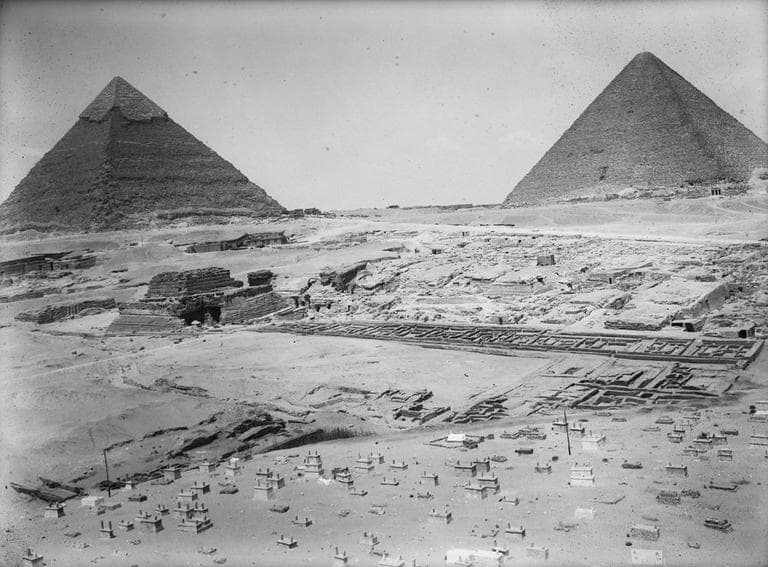
"And I'm going to drive with my mouse and I'll try not to crash into the walls," Manuelian pledged. "And I'll take you down, all the way to the bottom. I hope no one feels seasick!"
It is a little dizzying, and it's all very whiz-bang. But Harvard and the MFA insist this has an educational purpose, too: it's linked to the Giza Archive Project, a massive digital database of materials gathered during a decades-long joint Harvard-MFA expedition of the Giza Plateau. So you can click on anything you come across — say, a tomb — and immediately access all that digitized information.
"Lists of statues, ceramics, objects of daily life from that tomb, references to scholarly publications, maps and plans, old photographs, even unpublished manuscripts," Manuelian reeled off.
This kind of "edu-tourism" has the potential to bring ancient Egypt to the masses, he said. A French software company with U.S. headquarters in Waltham, Dassault Systemes, is behind this technology. One of its vice presidents, Mehdi Tayoubi, called the Giza 3D project the "democratization" of a high-tech tool.
"When a student is here, it's like he's in Giza traveling with Peter as a guide," Tayoubi said. "But back at home, he's able to connect online and to do the travel by himself and to look at some details not raised by Peter during his course," Tayoubi said.
And when Giza 3D goes public Tuesday, you might be able to pay a virtual visit to ancient Egypt, too.
The site will go live early Tuesday morning.
This program aired on May 7, 2012.
More from WBUR
The Giza Project at Harvard University
- Project Director Peter Der Manuelian
- Location Giza Plateau
- Affiliation Harvard University
- Project Dates 2000-Present
The Giza Project , a non-profit international initiative based at Harvard University, assembles information about all the archaeological activity at the most famous site in the world: the Giza Pyramids and surrounding cemeteries and settlements (third millennium BCE to present). Using digital archaeology, the Project unites diverse documentation to produce powerful online and traditional academic research tools and new teaching technologies. It presents academic information about Giza at all levels of expertise for the world community and strives to provide a model of archaeological information management.

The mission statement above describes a project that began back in 2000 at the Museum of Fine Arts, Boston, with generous support from the Andrew W. Mellon Foundation. Rather than simply scan all 45,000 glass plate expedition negatives from George Reisner’s Harvard University–Boston Museum of Fine Arts Expedition (1905–1947), we decided instead to focus on “just” the 21,000 Giza photos, but link them intelligently with as much additional metadata as possible. Assembling a team of Egyptologists, PhD candidates, undergraduates, volunteers, and talented and dedicated MFA Museum Associates women, we transcribed expedition diaries, created artifact databases from original object register books, scanned maps, plans, sections, and epigraphic drawings of scenes and inscriptions, and converted scholarly publications into a massive Giza digital library of text-searchable pdf files. Everything fit into its appropriate module in our TMS collections management system, now dubbed “GizaCARD,” and the Project’s first website launched in 2005. Each of the hundreds of Giza tombs surrounding the Pyramids became a central “node” in our system, linked to its appropriate photos, diary pages, object records, drawings, publications, etc.
Since focusing only on the parts of the Giza Necropolis excavated by the HU–MFA Expedition precluded any holistic attempt to study the entire site, we next brought on board all the museums and institutions with a direct archaeological connection to Giza. We have added digital data from Berkeley, Berlin, Cairo, Hildesheim, Leipzig, Philadelphia, Turin, and Vienna in an attempt to build “Giza International,” a sort of centralized repository. We also discovered in Egypt some seventy-four Arabic expedition diaries kept safely all these years by the descendants of George Reisner’s Egyptian foremen. Mellon Foundation funding totaled about $3.4 million and supported us from 2000 to 2010.
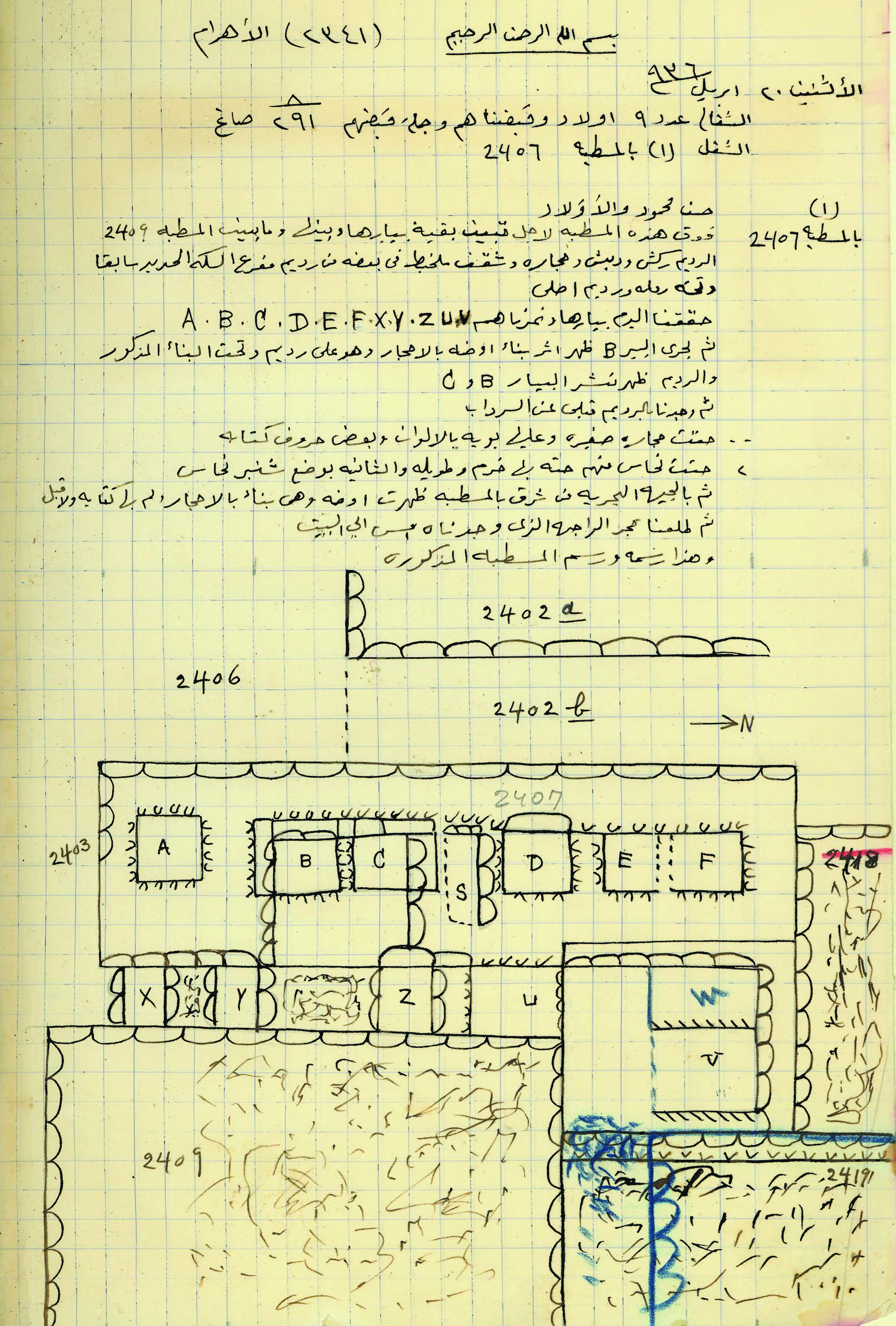
Aiming to take our digital data to the next level, we teamed up with French 3D modeling company Dassault Systèmes (Paris and Waltham, MA) and immersive experience and virtual/augmented reality partner Emissive (Paris) to build 3D models of Giza for teaching and research. Breathing new life into old data came in particularly handy in 2010 when the Giza Project moved to Harvard University. Like George Reisner himself (1867–1942), who was also an MFA curator and Harvard professor, the Giza Project was now able to represent both institutions in a collaborative partnership. The work also fed directly into undergraduate and graduate courses taught in Harvard’s customized Visualization Lab classroom.
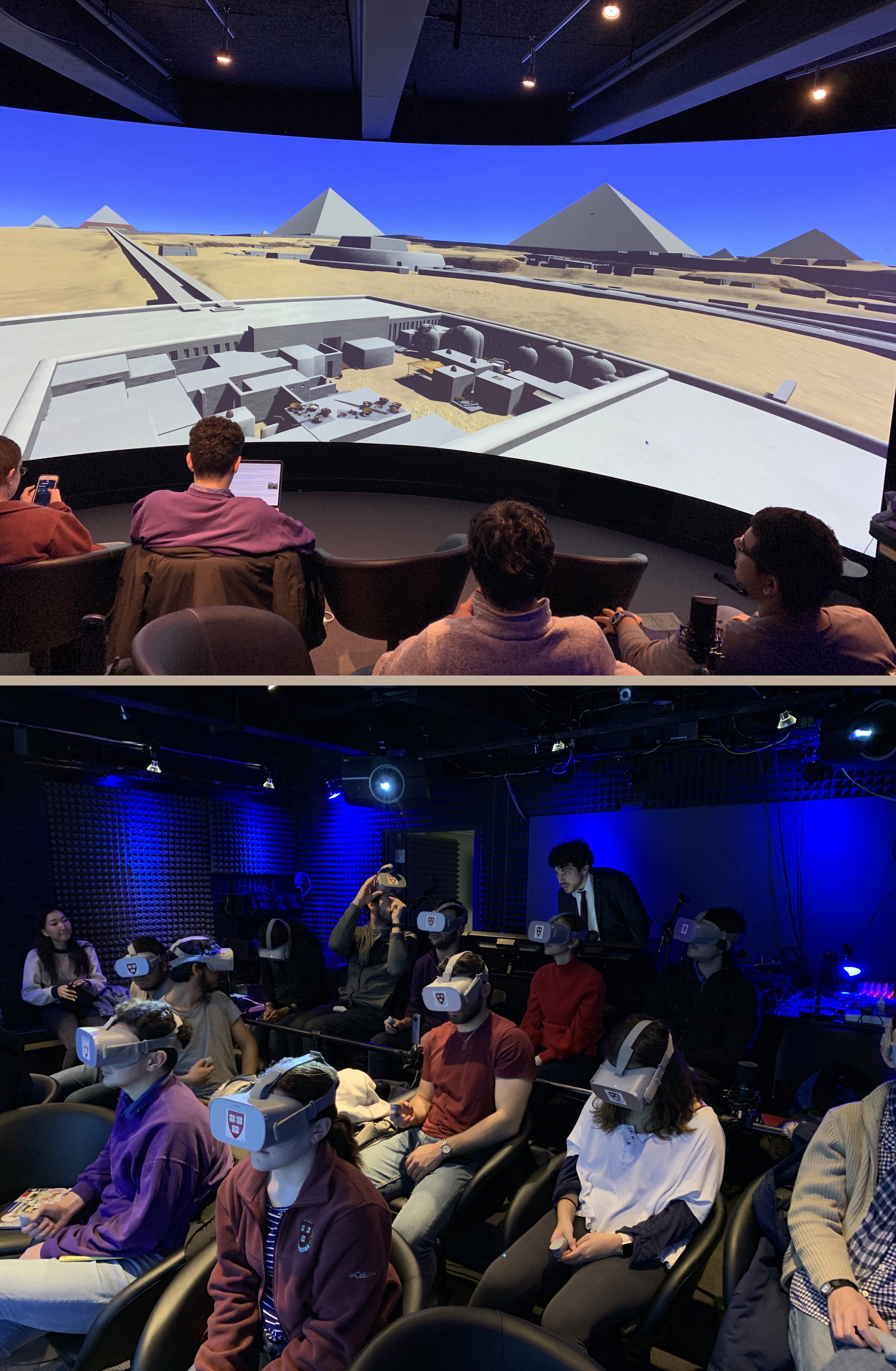
Supported by a series of NEH grants, the Giza Project at Harvard roughly doubled the number of records online over what had been collected at the MFA. We expanded into “educational telepresence,” building out 3D models, not only for our new Harvard-based website, but for immersive stereo headset use as well. The Project’s outreach expanded as well, and a HarvardX online “Giza Pyramids” course (8 modules, 60 videos) has reached a total enrollment at this writing of 116,639 learners from 160 countries. Some of our work overlapped with the mission of the Harvard Museum of the Ancient Near East, such as the free “Dreaming the Sphinx” augmented reality app for the Thutmose IV Sphinx Stela we launched on the Apple App and Google Play stores.

From 2018 onwards, the Giza Project teamed up with Zhejiang University (ZJU) in Hangzhou. Visiting computer scientist Dr. Changyu Diao joined us for a year, contributing to a wide variety of projects, including back-end web coding, live-streaming our Giza classes to China, and 3D scanning and 3D printing, the last item thanks to several PLA printers generously donated by Sindoh.
Now just over twenty years on, with 152,464 items at present in our “GizaCARD” database and on our website, we have recently been enhancing the website (figure 6), with a IIIF-compliant “Mirador” image viewer; the ability to save and share collections (“MyGiza”); and educational features such as “Giza@School,” including an interactive timeline on Giza archaeological history. Through collaboration with ICONEM we hope to combine drone footage with our own interactive tours and a GIS overlay that will allow for enhanced research as well as edu-tourism. New sourcing documents will explain how we built our 3D structures, while photogrammetry and Sketchfab object models and virtual tours of Giza tomb chapels will enable a host of new scholarship opportunities.
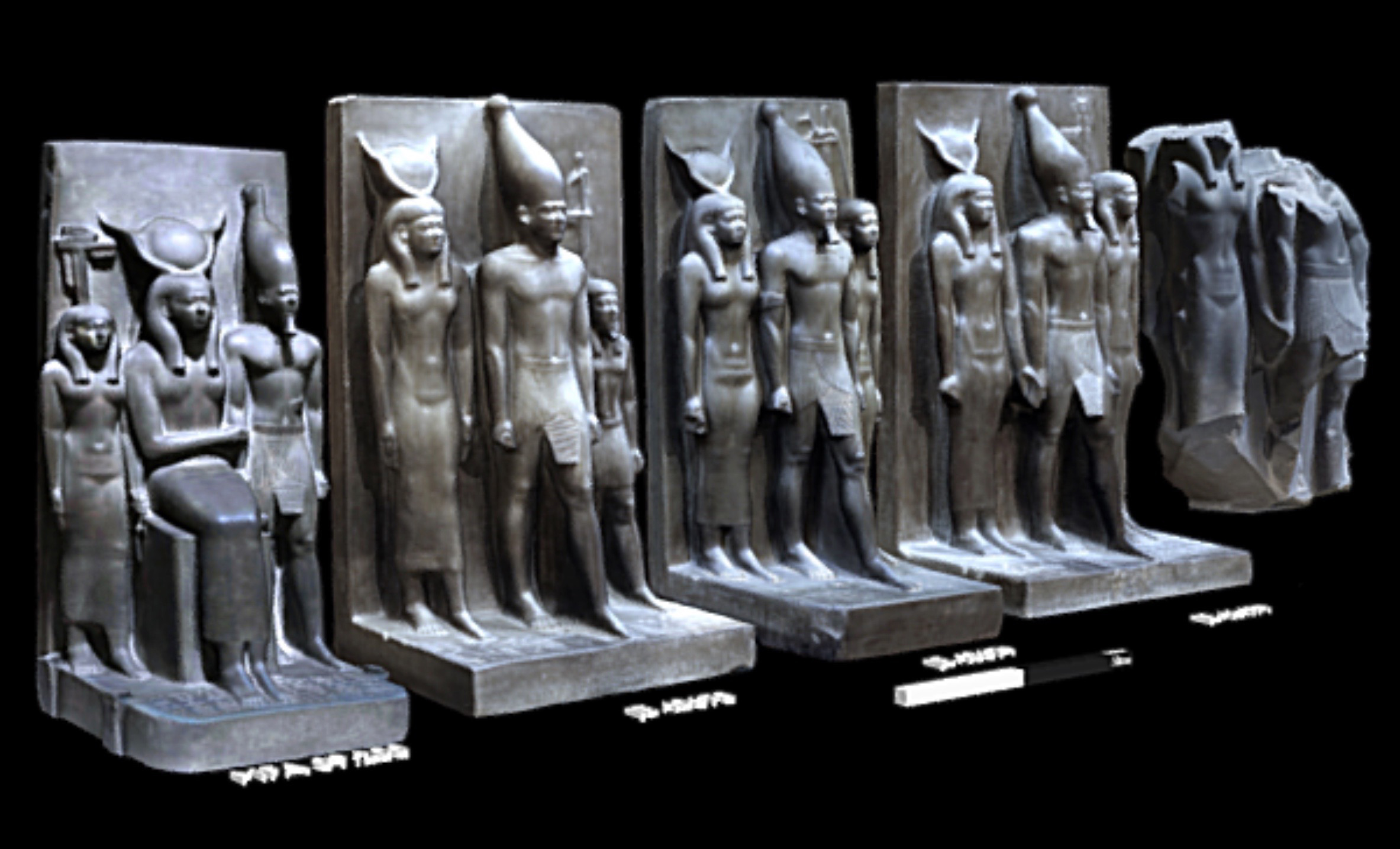
A description of the first decade of the Giza Project was published in 2017 by Harvard University Press . Funding remains an ongoing challenge but with proper support we hope to continue to document the past, present, and future at Giza, one of the world’s most important heritage sites.
- Nicholas Picardo, Project Supervisor and Research Associate
- Luke Hollis, Lead Technical Artist
Project Team Members:
After twenty years, the Giza Project has benefited from the work of almost 1,000 different people. Among those with fundamental contributions are Diane Flores, Catherine Pate, Nicholas Picardo, Rachel Aronin, Jeremy Kisala, Luke Hollis, Rus Gant, David Hopkins, Josh Widdicombe, Changyu Diao, and Harvard Egyptology and archaeology PhD candidates Laura Taronas, Kate Rose, Sara Zaia, Inês Torres, Hilo Sugita, Julia Puglisi, Sergio Alarcón Robledo, Nisha Kumar, and Gaia Bencini. We also thank Rashmi Singhal and Cole Crawford of DARTH, Jeff Steward (HAM), and Henry Perkins and the staff of Harvard’s FAS Research Computing. We also thank volunteers John Thompson, Doug Hall, Erika Kelley, Jenny Cashman, Daniel Leon, and Maarten Praet.
The Giza Project brings together archival holdings from a number of institutions, including:
- The Museum of Fine Arts, Boston (USA)
- The Ägyptisches Museum der Universität Leipzig (Germany)
- The Berlin Ägyptisches Museum (Germany)
- The Egyptian Museum, Cairo (Egypt)
- The Grand Egyptian Museum (Egypt)
- The Kunsthistorisches Museum, Vienna (Austria)
- The Museo Egizio, Turin (Italy)
- The Peabody Museum of Archaeology and Ethnology, Harvard University (USA)
- The Phoebe A. Hearst Museum of Anthropology, University of California, Berkeley (USA)
- The Roemer- und Pelizaeus-Museum, Hildesheim (Germany)
- The University of Pennsylvania Museum of Archaeology and Anthropology, Philadelphia (USA)
- Ancient Egypt Research Associates
The Giza Project gratefully acknowledges current and past support from the following organizations:
- The National Endowment for the Humanities
- Harvard University
- Mr. Sadek Wahba
- Google for Education
- Dassault Systèmes
- Leon Levy Foundation
- The Museum of Fine Arts, Boston
- Andrew W. Mellon Foundation
Renew Your Membership
Keep your ARCE membership by renewing
Support ARCE Today
Donate to support research into egypt's rich history and the preservation of its cultural heritage..

2024 Annual Meeting
Register Today!
- Utility Menu
Giza 3D: Visualizing the Pyramids

HUBweek comes to Cabot Science Library .
Join Peter Der Manuelian , Philip J. King Professor of Egyptology; Director, Harvard Semitic Museum; as he presents the HUBweek Spoke Event Giza 3D: Visualizing the Pyramids.
As part of the Giza Project at Harvard, a 3D, archaeologically accurate computer model of the pyramids, tombs, and temples at the famous Giza Pyramids, just west of modern Cairo, is being used for teaching and research. The work is largely based on the excavations of the Harvard University–Boston Museum of Fine Arts Expedition (1905–1947). This talk will show the computer model, and present other experiments in new technologies for bringing the site back to life, for scholars, students, and the public worldwide. Read more about Peter Der Manuelian and the Giza Project here .
What is HUBweek? Billed as a festival for the future, HUBweek explores the revolutionary intersections of art, science, and technology being created across Boston.
Pyramids of Giza: Ancient Egyptian Art and Archaeology
Explore the archaeology, history, art, and hieroglyphs surrounding the famous Egyptian Pyramids at Giza. Learn about Old Kingdom pharaohs and elites, tombs, temples, the Sphinx, and how new technology is unlocking their secrets.
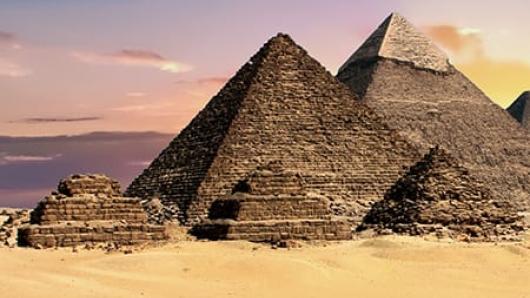
Associated Schools

Harvard Faculty of Arts & Sciences
What you'll learn.
Who explored the Pyramids and how they documented their discoveries
The cultural and religious significance of the Giza Pyramids, tombs, and temples
The role of hieroglyphic inscriptions in the tombs at Giza
An appreciation for Egyptian art of the Old Kingdom, or Pyramid Age
How digital technologies allow us to visualize ancient monuments in new ways
What the future holds for our understanding and experience of Giza
Course description
Where is Giza? How were the Pyramids built? How did the cemeteries and hundreds of decorated tombs around them develop? What was Giza’s contribution to this first great age of ancient Egyptian civilization, the Old Kingdom?
The Giza Plateau and its cemeteries — including the majestic Pyramids and the Great Sphinx — are stirring examples of ancient Egyptian architecture and culture. They provide windows into ancient Egyptian society, but also contain mysteries waiting to be solved. The Egyptian Pyramids at Giza provide an opportunity to explore the history of archaeology and to learn about some of the modern methods shaping the discipline today. This introductory course will explore the art, archaeology, and history surrounding the Giza Pyramids. We will learn about Egyptian pharaohs and high officials of the Pyramid Age, follow in the footsteps of the great 20th-century expeditions, and discover how cutting-edge digital tools like 3D-modeling are reshaping the discipline of Egyptology. Join us on this online journey to ancient Egypt’s most famous archaeological site as we uncover the history and significance of Giza, and use new digital techniques to unravel the mysteries of its ancient tombs and temples.
Instructors


Peter Der Manuelian
You may also like.

Tangible Things
Gain an understanding of history, museum studies, and curation by looking at, organizing, and interpreting art, artifacts, scientific curiosities, and the stuff of everyday life.

Japanese Books: From Manuscript to Print
Study Japanese scroll art as text and as "little movies" that immerse the viewer through visual narration.
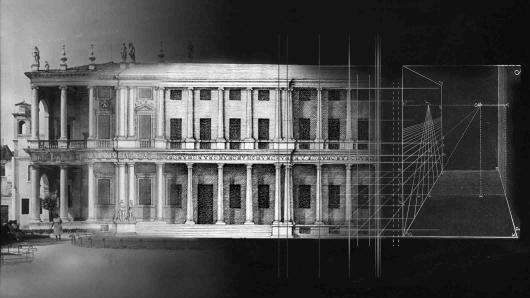
The Architectural Imagination
Learn fundamental principles of architecture — as an academic subject or a professional career — by studying some of history’s most important buildings.
- Web Stories
- Travel Diary
From Dream To Reality: Your Ultimate Guide To Exploring The Iconic Pyramids of Giza
On HerVoice, Manjulika Pramod her a long dream of visiting the Pyramids of Giza. Scroll down to know about her journey and Tips to plan your trip to the Pyramids of Giza in a better way.

- Guest Author
- Updated - 2024-04-04, 16:53 IST

The Pyramids of Giza Are Unique
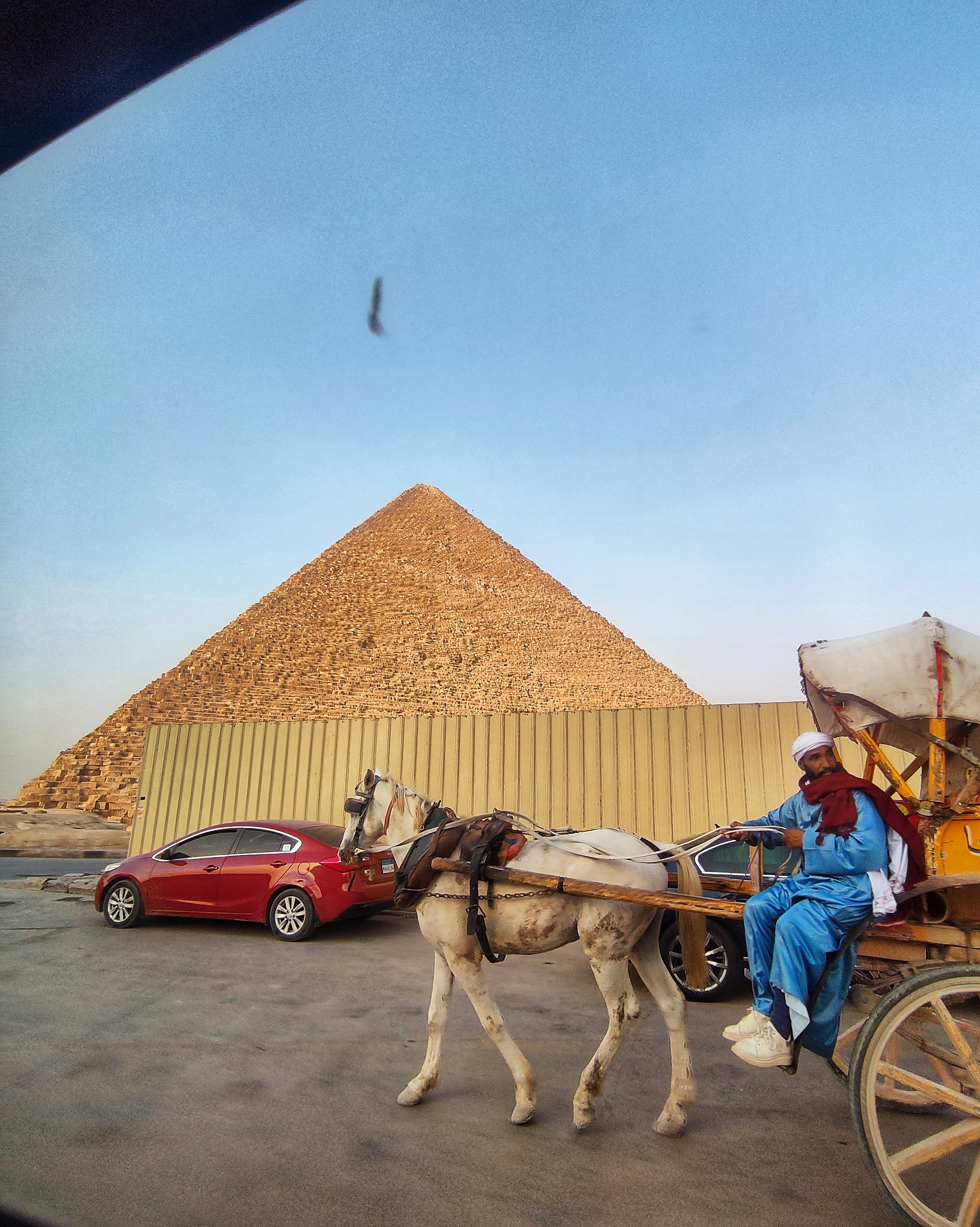
Tips To Plan Your Trip To The Pyramids of Giza Better
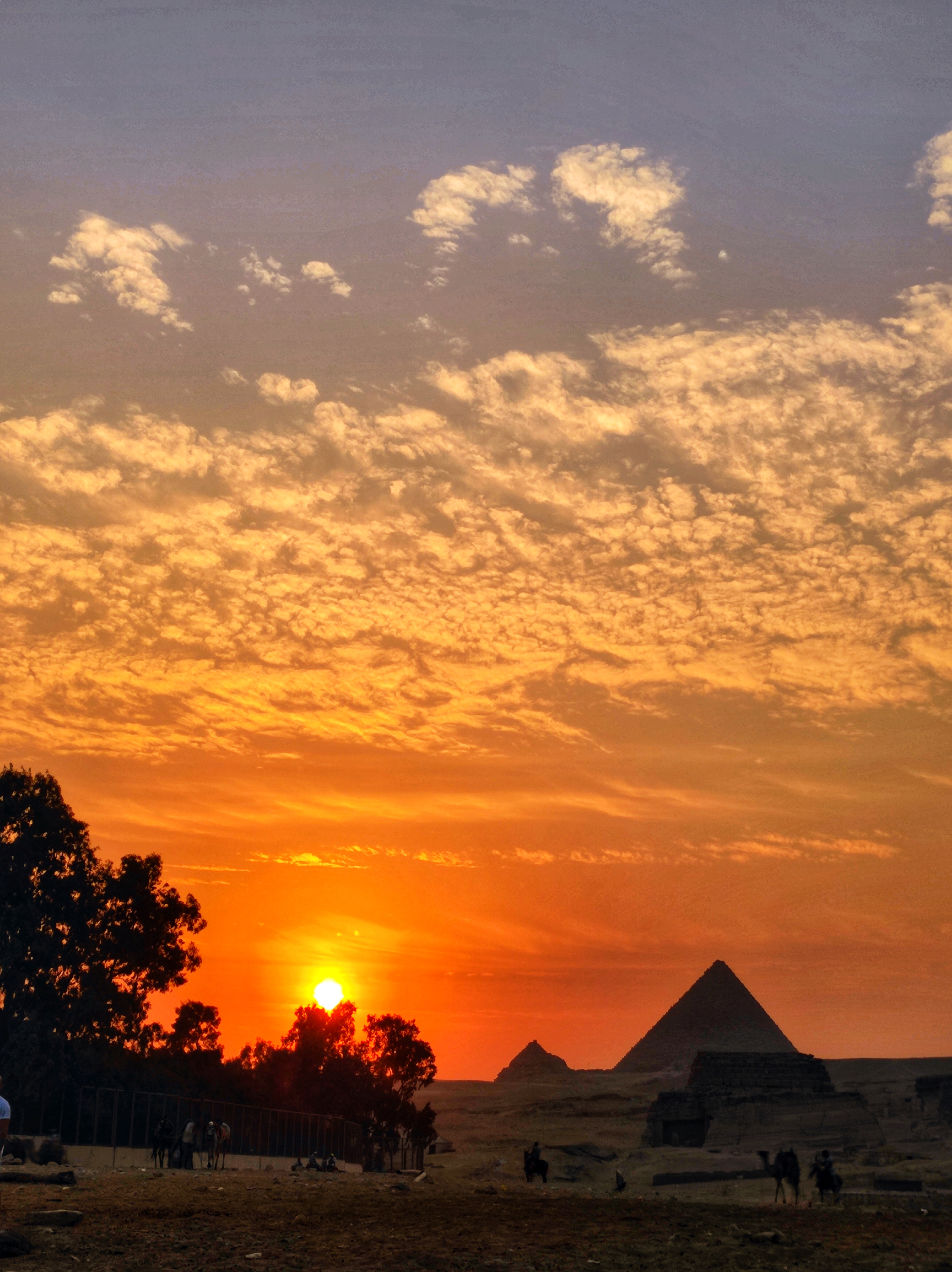
- Once you land in Cairo, take some rest, and plan your trip to the pyramids for the next day.
- The road distance between Cairo and the Pyramids of Giza is hardly 30 to 45 minutes. Depending on where you are staying, you can take a taxi, call for an Uber, or book an organized tour or a private tour.
- A guided trip is highly recommended because this way you will not miss out on the important information and insights about the structure.
- It is important to start early to save yourself from the serpentine queues and the scorching sun. Be there as soon as it opens.
- Wear light clothing but in line with Egyptian customs. Sunscreen, hats, and sneakers will be useful.
- There is a separate ticket if you wish to go inside the Pyramids. The stairs are very narrow. It may get stuffy inside but the experience is different.
- Be very careful of your camera and other belongings.
- There are no security issues whatsoever. You will find tourist police around.
- Ask for the panoramic point where you can get a great view of all three pyramids.
- Camel rides may be avoided.
- Do not miss the Sphinx which has the body of a lion and a head that is believed to be Khafre.
Easy Travel From India To Egypt

Your skin and body like you are unique. While we have taken all measures to ensure that the information provided in this article and on our social media channels is credible and expert verified, we recommend you consult a doctor or your dermatologist before trying a home remedy, quick hack or exercise regime. For any feedback or complaint, reach out to us at [email protected]

What You Need To Know About The Three Chambers Of The Great Pyramid (& What You Can See On A Tour)
- The Great Pyramid of Giza is the only one of the Seven Wonders of the Ancient World still standing today and is a popular tourist destination.
- The pyramids were sealed off to protect their secrets and treasures, but tourists can now see some of the chambers and passageways.
- The Great Pyramid was built as a mausoleum for the Pharaoh Khufu and took around 27 years to construct. Visitors can explore the King's Chamber and other hidden passageways.
The Great Pyramid of Giza is the only one of the Seven Wonders of the Ancient World still standing today and it has long captured the imagination of the many generations that have seen it (from the Greeks to the Romans to the modern era). During the Roman era, the pyramids were among the tourist destinations of Rome . The Great Pyramid has a number of chambers and some of these can be seen by tourists today.
The pyramids were sealed off and no one was meant to enter them to see (and loot) their secrets and treasures. The pyramids of Giza were encased with smooth white limestone and were part of a complex with satellite pyramids, temples, causeways, and more. The pyramids looked very different when they were first built , but visitors can glimpse them today. Here's what to know about touring the Great Pyramid.
Size & Purpose Of The Great Pyramid Of Giza
The Great Pyramid of Giza is the largest pyramid in Egypt (only a little larger than the Pyramid of Khafre) and was built as a mausoleum for the Pharaoh Khufu. It should be noted that the Ancient Egyptians did not see the pyramids as 'tombs' or their pharaohs as 'dead.' Instead, the pyramids were part of a larger complex designed to take the pharaoh to the afterlife.
- Built: 26th Century BC
- Height: 481 feet (original); 454 feet (today)
The Great Pyramid was built in the early 26th century BC and took around 27 years to construct. For some 3,800 years, the Great Pyramid was the tallest building in the world (originally 146.6 meters or 481 feet tall, now 138.5 meters or 454.4 feet tall).
The Great Pyramid is the most famous monument of the Giza Necropolis or Giza Pyramid Complex .
Related: The Great Sphinx Was Likely Part Of This Pyramid Complex
The Three Known Chambers Inside The Great Pyramid Of Giza
The Great Pyramid is awe-inspiring from the outside but somewhat underwhelming on the inside. There are three main known chambers inside the Great Pyramid. Additionally, there is the Grand Gallery and various corridors and shafts.
There are more secrets of the Great Pyramid still waiting to be discovered. A new passageway or hidden corridor was announced to have been discovered in March 2023 that measures some 9 meters or 30 feet long and 2 meters or 6 feet wide. It was found with non-invasive scans near the main entrance.
Subterranean Chamber
One of these chambers is not even in the pyramid per se , instead, the Subterranean Chamber (or 'Pit') was cut into the bedrock beneath the pyramid. This chamber remains unfinished and is located 89 feet or 27 meters below the base level. This room measures 27.5 feet by 46.4 feet and has a height of 13 feet.
The access to the Subterranean Chamber is through the Descending Passage, and it has been suggested that this may have been intended as the burial place for the pharaoh. This plan was changed later in favor of the King's Chamber higher in the pyramid.
This chamber was rediscovered in 1817.
Queen's Chamber
The Queen's Chamber is linked to the Grand Gallery by the Horizontal Passage. Despite its name, it is unlikely that a queen was buried there. Instead, it seems more probable that it once housed a life-size statue of the pharaoh.
The floor is rough, almost as though it's unfinished. The room measures 17 feet by 19 feet and the ceiling is 20.6 feet at the apex. The room is completely void of any contents with anything placed in the chamber removed long ago.
King's Chamber
The King's Chamber is the highest of the three main chambers and is completely faced with granite. This was the burial chamber of the Great Pyramid. Above the chamber are five compartments that were separated by huge horizontal granite slabs; these were likely meant to divert the massive weight of the pyramid above.
The chamber measures 34.4 feet by 17.2 feet and its ceiling is 19 feet high.
The only object still remaining in the chamber is the sarcophagus which is made out of a single granite block. The King's Chamber was rediscovered in the Early Middle Ages and it was quickly plundered for anything that was stored in the chamber.
Related: Pyramid of Cestius: See The Ancient Roman Pyramid That Was Inspired By Egypt's Ancient Pyramids
Tour Inside The Great Pyramid While In Giza
Visitors can go inside the Great Pyramid (as well as the neighboring Pyramids of Khafre and Menkaure). It is a separate ticket to go in each of the pyramids in addition to admission to the archeological site.
- Entry Fee Giza Pyramids Site: 240 Egyptian Pounds ($8 USD)
- Entry Fee Great Pyramid: 440 Egyptian Pounds ($14 USD)
- Opening Hours: 8:00 am to 5:00 pm
Visitors need to walk through narrow passageways (having to stoop down in places). Tourists see the King's Chamber and some of the other hidden passageways. It is perhaps surprising that the largest building in the world for thousands of years is actually cramped inside.
While in Giza, take the time to see the other Ancient Egyptian necropolises and see the other impressive pyramids of Egypt .

- Giza @ School
- You are not logged in.
- Create a MyGiza account
- Browse Collections
Introduction to Giza
- What is the Giza Project?
- Archaeology at Giza
This brief summary describes the basic history of the Giza Plateau. For a closer look at some of the most popular topics, people, and places related to ancient Giza, check out Giza @ School .
The Giza Plateau of Egypt. Located about 15 miles southwest of modern Cairo, Giza is home to the Great Pyramid , the only one of the Seven Wonders of the Ancient World still standing.
Built by King Khufu (also known as Cheops) in the Fourth Dynasty of ancient Egypt’s Old Kingdom (around 2550 BCE), the Great Pyramid was the largest ever constructed in Egypt, originally reaching a height of 481 feet.
The Giza Plateau is also home to two other major pyramids, built by Khufu's successors:
- the Pyramid of Khafre (also known as Chephren ), whose burial complex includes the second-largest pyramid as well as the Sphinx .
- and the Pyramid of Menkaure (also known as Mycerinus ), smallest of the three pyramids at Giza.
As these royal complexes were constructed, and even long after kings began to build their monuments elsewhere, hundreds of tombs were systematically added to cemeteries surrounding the pyramids, to serve as the eternal resting places for the royal family and bureaucratic elite.
Among these individuals were:
- Khufu's mother, Queen Hetepheres I , whose mysterious burial was hidden nearly 90 feet (30 meters) underground;
- the vizier (or prime minister) Hemiunu , architect of the Great Pyramid ( his tomb );
- and Queen Meresankh III , owner of a unique, beautifully decorated tomb east of her grandfather Khufu’s pyramid.
This was all during a time referred to as the Old Kingdom (about 2650–2150 BCE). In this period of strong central government, kings were able to organize the immense amounts of labor and resources from all over Egypt required for such vast building projects. Many officials of the time also chose to be buried at the Giza Plateau, because it was near the capital and the focus of administrative power.
The old Kingdom collapsed, and a period of weakened central control in Egypt followed, along with the rise of powerful local district rulers. Officials built their tombs at smaller regional burial grounds, closer to the local centers of power and away from the primary elite cemeteries of the capital region, including Giza.
As a result, building at Giza tapered off, and was not resumed even with the reunification of Egypt under a single, strong dynasty during the Middle Kingdom (about 2060–1640 BCE).
After another period of fractured rule and civil war, Egypt rose to new heights of imperial power during the New Kingdom (about 1550–1070 BCE), and renewed to Giza and especially the Sphinx occurred. Several pharaohs of Dynasties 18 and 19 built or added onto chapels in the area of the Sphinx.
King Thutmose IV cleared away the sand which had buried the Sphinx's body after supposedly having a vision which would grant him the kingship in return. He became king and commemorated the event with a nearly 12-foot (3.6 meters) tall stone monument now called “the Dream Stela.” Set between the front legs of the Sphinx, Thutmose's stela still stands there today.
With the close of the New Kingdom, yet another era of decline and political instability was followed by a period of foreign rule over Egypt. Then Egyptian kings of Dynasty 26 broke free of foreign control and established a new central government.
These kings tried to validate their reigns by emphasizing their native Egyptian-ness. This sparked a surge of interest in Egypt's past, especially in the glory days of the Old Kingdom. Already ancient by then, the Pyramids were iconic images of Egypt, and the elite returned once more to Giza, digging new burial shafts across the plateau—many of them intruding into existing Old Kingdom structures.
While the Pyramids identify Giza as the great royal cemetery of ancient Egypt’s earliest state, the Giza Plateau preserves a much broader window into the first flourishing of ancient Egypt, one of the world’s first great civilizations, including:
- Tomb scenes that capture snapshots of everyday lives and beliefs of Egyptians from all walks of life;
- Settlements that offer opportunities to walk the same halls where ancient feet once passed;
- And burial remains that give us a modern understanding of the lives of individual Egyptians.
Although Giza thrived several millennia ago, connecting with ancient Egyptian culture now through the site's history and archaeology provides insight into not only the differences but, more importantly, the many similarities between the ancient and modern experiences of being human.
Suggested reading:
Lehner, Mark and Zahi Hawass. Giza and the Pyramids: The Definitive History. Chicago: University of Chicago Press, 2017.
Manuelian, Peter Der. "Excavating the Old Kingdom. The Giza Necropolis and Other Mastaba Fields." In Egyptian Art in the Age of the Pyramids , pp. 138–153. New York: The Metropolitan Museum of Art, 1999.
Manuelian, Peter Der. Digital Giza. Visualizing the Pyramids. Cambridge and London: Harvard University Press, 2017.
Back to top
Name of this image
Description of the image duis mollis, est non commodo luctus, nisi erat porttitor ligula, eget lacinia odio sem nec elit. Sed posuere consectetur est at lobortis. Donec sed odio dui.
- Heather ONeill [email protected] ×
- Nicholas Picardo [email protected] ×
- Luke Hollis [email protected] ×
- Cole Test Collection - Tomb Chapels and Shafts
- GPH Test Collection 1
- Tombs & Monuments
- Sphinx Complex
- 01-Present location
- Architectural element
- 02-Category
- 05-Material
- 06-Technique
- 07-State of preservation
- 08-Description
- Selected (2)
Questions, comments, concerns? We'd love to hear from you.
All fields below are required. Please note: although we make every effort to respond, we are unable to personally reply to every comment.
- Manage Account
Metro Boomin Announces Special One-Off Show at Pyramids of Giza in Egypt
The April 30 gig will take place at the Kundalini Grand Pyramids.
By Gil Kaufman
Gil Kaufman
- Share this article on Facebook
- Share this article on Twitter
- Share this article on Flipboard
- Share this article on Pinit
- + additional share options added
- Share this article on Reddit
- Share this article on Linkedin
- Share this article on Whatsapp
- Share this article on Email
- Print this article
- Share this article on Comment
- Share this article on Tumblr

Metro Boomin
See latest videos, charts and news
J. Cole Appears to Take Aim at Kendrick Lamar on '7 Minute Drill': Listen
Trending on billboard.
Metro’s gig comes a little under a year after Travis Scott tried to book a gig at the pyramids, which he ultimately canceled due to what producer Live Nation dubbed “ complex production issues .”
Rapper/producer Boomin riding high at the moment after his single with Future and Kendrick Lamar, “Like That,” rocketed to No. 1 on the Billboard Hot 100, marking Boom’s first Hot 100 leader as a billed recording artist, following two as a writer and producer; the song is Future and K-Dot’s third Hot 100 leader each. The single was one of five from Future and Metro’s joint album, We Don’t Trust You , which debuted in the top 10; the album debuted at No. 1 on the Billboard 200 album chart.
Check out the Giza gig poster below.
In other news I’m doing a show at the Pyramids in Giza 🤯🤯🤯 pic.twitter.com/urgf9BgH1x — Metro Boomin (@MetroBoomin) April 2, 2024
Get weekly rundowns straight to your inbox
Want to know what everyone in the music business is talking about?
Get in the know on.
Billboard is a part of Penske Media Corporation. © 2024 Billboard Media, LLC. All Rights Reserved.
optional screen reader
Charts expand charts menu.
- Billboard Hot 100™
- Billboard 200™
- Hits Of The World™
- TikTok Billboard Top 50
- Song Breaker
- Year-End Charts
- Decade-End Charts
Music Expand music menu
- R&B/Hip-Hop
Culture Expand culture menu
Media expand media menu, business expand business menu.
- Business News
- Record Labels
- View All Pro
Pro Tools Expand pro-tools menu
- Songwriters & Producers
- Artist Index
- Royalty Calculator
- Market Watch
- Industry Events Calendar
Billboard Español Expand billboard-espanol menu
- Cultura y Entretenimiento
Honda Music Expand honda-music menu
Best Driving Vacations 2024: Columbus, Indiana, has worldly architecture, small-town charm
This southern indiana city boasts buildings from i.m. pei and eero saarinen, as well as public art and seven national historic landmarks..

Today, we present the final installment in the best driving destinations from central Ohio. We hope you have enjoyed the series.
An architectural pilgrimage to Columbus, Indiana
Finnish architect Eero Saarinen said, “The purpose of architecture is to shelter and enhance man's life on earth and to fulfill his belief in the nobility of his existence."
Indeed, in his most celebrated works — the Gateway Arch in St. Louis or the sleek, futuristic TWA Flight Center at New York’s Kennedy Airport — Saarinen created structures with the intent that they would be gazed upon for generations, masterpieces that would become destinations, much like the Pyramids of Giza or the Colosseum in Rome.
One need not travel far from Ohio to make an architectural pilgrimage the focal point of a road trip. There’s Chicago, New York or Washington, D.C., a day’s drive away, of course. But just three hours west, in the small, southern Indiana prairie town of Columbus , sits an oasis of modern architecture. A place where the most elite architects in the world have made their playground.
Part 1: Best Driving Vacations 2024: Explore the Northern Shore of Michigan’s Upper Peninsula
This other Columbus (population 50,000) earned this distinction thanks to the vision of J. Irwin Miller . In a post-WWII landscape, he wanted to attract the country’s brightest engineers to work for his Cummins engine corporation. As an incentive, he created the Cummins Foundation, which supports ambitious architectural projects throughout the town.
The first contract, Lillian Schmitt Elementary, went to architect Harry Weese in 1954. From there, the foundation snowballed — everything from the fire stations to the hospitals, the park restrooms, City Hall and even the Bartholomew County Jail is a photo opportunity for architecture enthusiasts. Roaming the town is a moveable feast of brutalism, midcentury modernism and beyond.
The best way to see Columbus is through its celebrated two-hour architecture tour (make reservations well in advance). The knowledgeable guides start at I.M. Pei’s fortress-like Cleo Rogers Memorial Library and end with an up-close visit inside of Saarinen’s breathtaking North Christian Church, which resembles a spaceship that has landed in the bucolic environs.
Part 2: Best Driving Vacations 2024: Take a Battlefield Tour of Pennsylvania and Maryland
Columbus boasts seven national historic landmarks, most of which can be seen on the tour. A personal favorite is the minimal and spartan former home of The Republic newspaper, designed by Myron Goldsmith in 1971.
In the afternoon, a tour of the Miller House is a must. Opened in 2011, it was purchased by Newfields, Indianapolis’ modern art institution. Since 1957, it has sat far from the road, obscured by a landscape by Dan Kiley. Exposing it was akin to opening the doors of Willy Wonka’s factory.
Alexander Girard’s bright and colorful interiors tie the whole place together. Seeing the retro-futuristic, step-in sitting room is much like visiting that Colosseum. It might just be Saarinen’s masterpiece.
Columbus is entirely walkable, replete with public art from the likes of Robert Indiana and Dale Chihuly . Exploring further can allow you to sit for a drink in Lucabe Coffee Co., which has repurposed Weese’s award-winning Irwin Bank and Trust, or walk the methodically designed Mill Race City Park along the banks of the Flatrock River.
Downtown offers a stark contrast to the city’s famous modern architecture, featuring faithfully restored, late-19th century, Victorian-style storefronts. The centerpiece is Zaharakos Old-Fashioned Ice Cream Parlor. Still using the same methods since opening in 1900, it features a real soda fountain and a calliope. Order a Green River and the Gom Cheese Brr-Grr, a variation on the sloppy Joe filled with American cheese on toast.
Part 3: Best Driving Vacations 2024: Go on the ultimate full-circle adventure around Lake Erie
Elsewhere, the three-story kidscommons is an exceptional children’s museum for a town this size. Need a libation? The Indiana-famous Upland Brewing has a taproom close by. And the surrounding prairie, through which the statelong People Trail passes, has myriad options for outdoor adventures.
Columbus, Indiana, is not an artifact. Even if the goal is midcentury nostalgia, it’s constantly evolving. In fact, it’s a living laboratory, as Indiana University currently has a graduate architecture program there. The Cummins Foundation, too, is still thriving.
Currently on the docket is a new air-traffic control tower for the regional airport, with a short list of architecture firms vying to design it. At every turn, that “nobility of man’s existence” is in the structures and design of daily life of Columbus. It’s got both small-town charm and worldly ambitions.
Where to Stay in Columbus, Indiana
Prominently featured in Kogonada’s heralded 2017 debut film “Columbus , ” the Inn at Irwin Gardens is a Victorian mansion that is best visited during late spring when the grounds are in full bloom.
It’s an interesting alternative to the modern architecture that draws visitors to Columbus. Those on a budget can opt for the Hotel Indigo , which was built for the purpose of receiving architecture tourism. irwingardens.com , ihg.com/hotelindigo/hotels/us/en/columbus/clubs/hoteldetail
Take a Side Trip to Richmond, Indiana
If you triangulate your trip down I-71 to Columbus, spending a night in Indianapolis and heading home east on I-70, it’s certainly worth a stop in Richmond, Indiana, to see the Gennett Records Walk of Fame .
From 1872 to the turn of the century, Starr Piano in Richmond was one of the country’s largest manufacturers. In 1915, the company started making phonographs and records. In the shadow of the former factory, one can see the spot of their hand-powered recording studio and a line of plaques on the path that celebrate Charlie Patton, Louis Armstrong, Duke Ellington and other luminaries who recorded there. visitrichmond.org/listing/gennett-records-walk-fame
This story is from the Best Driving Vacations package in the February 2024 issue of Columbus Monthly.

IMAGES
COMMENTS
Giza 3D. Start Tour. Explore the models and tours; you will find links to other models throughout. Or choose from individual tours below.
The Giza Project, an international collaboration based at Harvard University, aims to assemble and provide access to all archeological records about the most famous site in the world: the Pyramids, surrounding cemeteries and settlements of Giza, Egypt.
Photos by Stephanie Mitchell/Harvard Staff Photographer. Alvin Powell Harvard Staff Writer May 15, 2019 long read Digital Giza Project lets scholars virtually visit sites in Egypt and beyond, and even print them in 3D ... Manuelian's team has already created video-game-like 3D versions of the entire Giza Plateau, with the Khafre pyramid, the ...
The Giza Project is a non-profit international initiative based at Harvard University. Through digital archaeology, we assemble, curate, and present archaeological records about one of the most famous archaeological sites in the world, the Giza Pyramids and surrounding cemeteries and settlements. The Project manages arguably the world's ...
Thanks to Harvard University, you can now virtually see the Great Pyramid of Giza from the inside in 3D and 360º.Tour: https://giza.mused.org/en/guided/266/i...
Take a walking tour of the Giza Pyramids with Harvard Professor Peter Der Manuelian.From our online course, "Pyramids of Giza: Ancient Egyptian Art and Archa...
Animated video production that provides a general, introductory tour of the Giza Plateau. The Giza Project at Harvard University http://giza.fas.harvard.edu ...
The Egyptian Pyramids at Giza provide an opportunity to explore the history of archaeology and to learn about some of the modern methods shaping the discipline today. This introductory course will explore the art, archaeology, and history surrounding the Giza Pyramids. We will learn about Egyptian pharaohs and high officials of the Pyramid Age ...
Giza 3D: Harvard's Journey to Ancient Egypt. October 14, 2016. Harvard University brings the Giza Plateau to life. Watch to learn more about their Giza 3D project, the Harvard Semitics Museum, and virtual reality technology of the future. Peter Der Manuelian. Barbara Bell Professor of Egyptology. Director, Harvard Museum of the Ancient Near East.
Take the Digital Giza Project at Harvard University, for example. From the comfort of our living rooms, we can read about the Great Pyramids of Giza—and even go on 3D tours. The project, which ...
Researchers at Harvard University and the Museum of Fine Arts are turning it into a learning tool, too. Beginning Tuesday, they're offering you a free 3D virtual tour of the ancient pyramids of ...
The Giza Project, a non-profit international initiative based at Harvard University, assembles information about all the archaeological activity at the most famous site in the world: the Giza Pyramids and surrounding cemeteries and settlements (third millennium BCE to present). Using digital archaeology, the Project unites diverse documentation to produce powerful online and traditional ...
Animated video production that provides a guided tour of the main components of the Khafre Pyramid Complex at Giza. The Giza Project at Harvard University ht...
This introductory course will explore the art, archaeology, and history surrounding the Giza Pyramids. We will learn about Egyptian pharaohs and high officials of the Pyramid Age, follow in the footsteps of the great 20th-century expeditions, and discover how cutting-edge digital tools like 3D-modeling are reshaping the discipline of Egyptology.
Thanks to the Digital Giza Project from Harvard University, you can take a virtual tour through ancient Egyptian pyramids and tombs from the comfort of your home. The Giza Project provides couch-surfing tourists with the tools and information gathered by academics, to learn all about one of the world's oldest attractions. Started by the ...
As part of the Giza Project at Harvard, a 3D, archaeologically accurate computer model of the pyramids, tombs, and temples at the famous Giza Pyramids, just west of modern Cairo, is being used for teaching and research. The work is largely based on the excavations of the Harvard University-Boston Museum of Fine Arts Expedition (1905-1947).
This introductory course will explore the art, archaeology, and history surrounding the Giza Pyramids. We will learn about Egyptian pharaohs and high officials of the Pyramid Age, follow in the footsteps of the great 20th-century expeditions, and discover how cutting-edge digital tools like 3D-modeling are reshaping the discipline of Egyptology.
Animated video production that tells the story of the hidden Giza tomb of Queen Hetepheres, as told by Hetepheres herself along with George Reisner, the archaeologist who excavated the tomb and all of its contents in the early 1900s. Together they relate the mystery surrounding the Queen's final resting place.
The Giza Project. The Giza Project at Harvard University gives you access to the largest collection of information, media, and research materials ever assembled about the Pyramids and related sites on Egypt's Giza Plateau, including 3D tours of Egypt's most iconic sites.
MyGiza: Save, share, and make our collection your own. MyGiza helps you explore the vast Digital Giza collection, and organize it in a way that makes sense for you. For example, take a look at some of our curated collections below - then sign up to make your own. Your First Collection No items - start adding some! Start collecting now with ...
The road distance between Cairo and the Pyramids of Giza is hardly 30 to 45 minutes. Depending on where you are staying, you can take a taxi, call for an Uber, or book an organized tour or a private tour. A guided trip is highly recommended because this way you will not miss out on the important information and insights about the structure.
Harvard University Unveils Groundbreaking 3D and 360º Virtual Tour of the Great Pyramid of Giza #harvard #pyramid #pyramidofgiza #egypt
Built: 26th Century BC. Height: 481 feet (original); 454 feet (today) Giza Necropolis or Giza Pyramid Complex. Related: There are more secrets of the Great Pyramid still waiting to be discovered ...
The Giza Plateau of Egypt. Located about 15 miles southwest of modern Cairo, Giza is home to the Great Pyramid, the only one of the Seven Wonders of the Ancient World still standing. Built by King Khufu (also known as Cheops) in the Fourth Dynasty of ancient Egypt's Old Kingdom (around 2550 BCE), the Great Pyramid was the largest ever ...
04/4/2024. Metro Boomin photographed on August 31, 2023 at Woodbury Story House in Altadena, Calif. Sami Drasin. Metro Boomin is taking his show on the road to Egypt later this month. On Tuesday ...
Best Driving Vacations 2024: Columbus, Indiana, has worldly architecture, small-town charm. This southern Indiana city boasts buildings from I.M. Pei and Eero Saarinen, as well as public art and ...